Collaboration Between Humans and AI in the Workplace: A Report
VerifiedAdded on 2023/01/13
|8
|1985
|59
Report
AI Summary
This report delves into the multifaceted relationship between artificial intelligence and human workers within the modern workplace. It begins by providing a foundational overview of AI, emphasizing its capacity to simulate human intelligence and perform complex tasks. The main body of the report examines the collaborative dynamics between humans and AI, highlighting how AI tools are utilized for planning, managing, and problem-solving, while also augmenting human capabilities. The report discusses the ways AI is transforming decision-making processes, enhancing worker engagement, and fostering innovative approaches to complex challenges. It explores the impact of AI on the human experience of work, including changes in job roles, skill requirements, and the overall work environment. The report also addresses the potential for AI to improve productivity, profitability, and employee satisfaction. The conclusion summarizes the key findings, emphasizing the significance of human-AI collaboration in driving operational efficiency and organizational development.
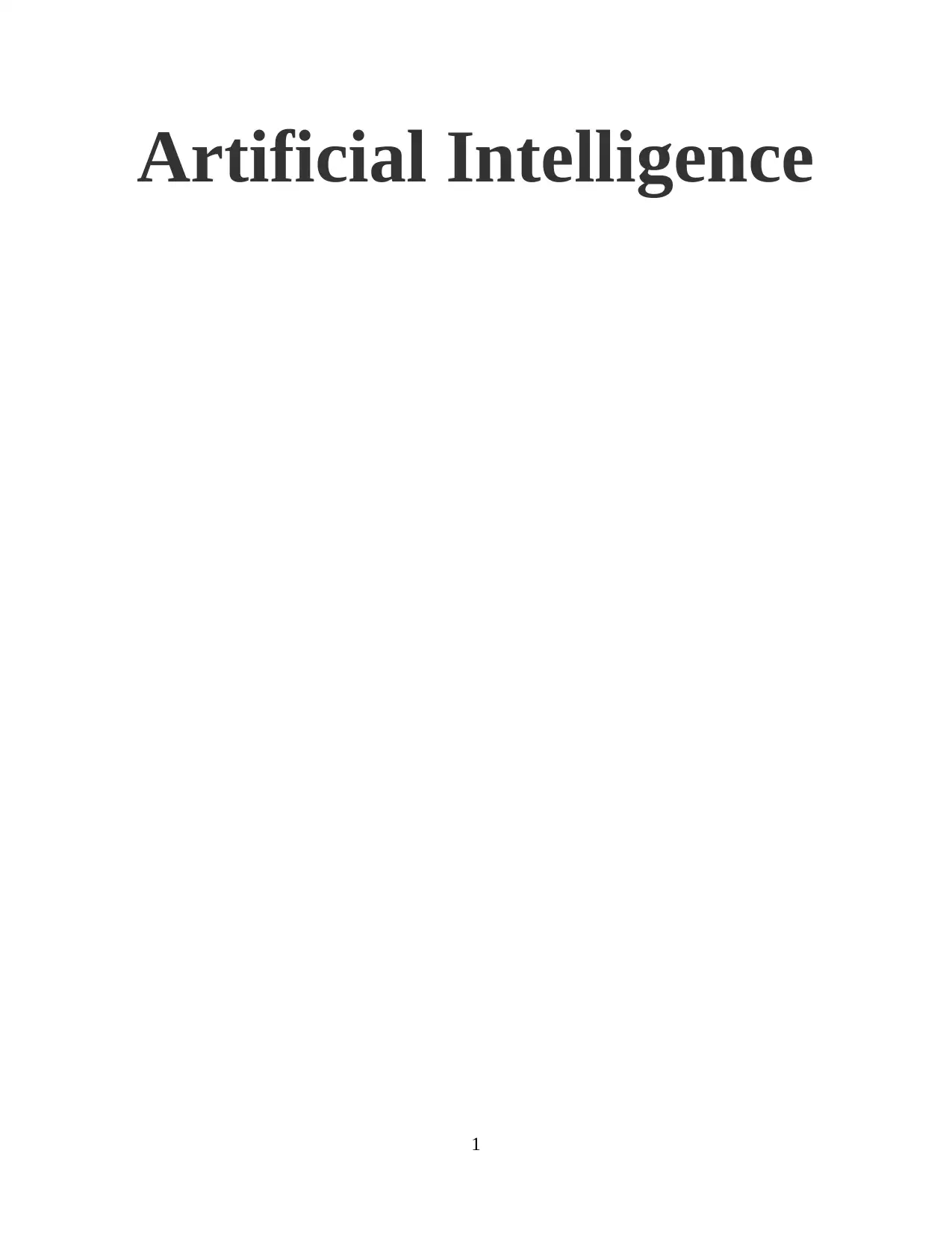
Artificial Intelligence
1
1
Paraphrase This Document
Need a fresh take? Get an instant paraphrase of this document with our AI Paraphraser

Contents
INTRODUCTION...........................................................................................................................3
MAIN BODY..................................................................................................................................3
CONCLUSION................................................................................................................................7
REFERENCES................................................................................................................................8
2
INTRODUCTION...........................................................................................................................3
MAIN BODY..................................................................................................................................3
CONCLUSION................................................................................................................................7
REFERENCES................................................................................................................................8
2
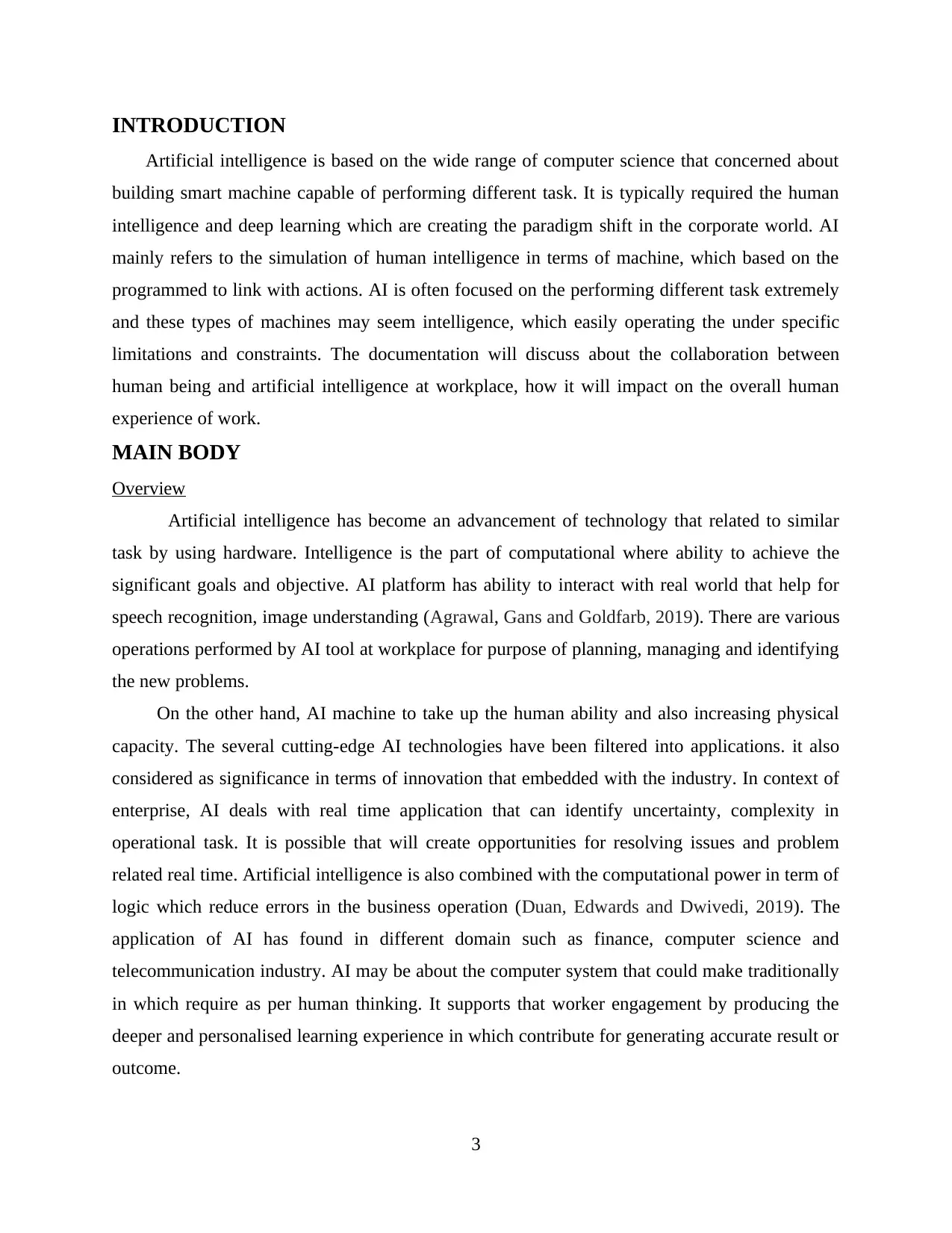
INTRODUCTION
Artificial intelligence is based on the wide range of computer science that concerned about
building smart machine capable of performing different task. It is typically required the human
intelligence and deep learning which are creating the paradigm shift in the corporate world. AI
mainly refers to the simulation of human intelligence in terms of machine, which based on the
programmed to link with actions. AI is often focused on the performing different task extremely
and these types of machines may seem intelligence, which easily operating the under specific
limitations and constraints. The documentation will discuss about the collaboration between
human being and artificial intelligence at workplace, how it will impact on the overall human
experience of work.
MAIN BODY
Overview
Artificial intelligence has become an advancement of technology that related to similar
task by using hardware. Intelligence is the part of computational where ability to achieve the
significant goals and objective. AI platform has ability to interact with real world that help for
speech recognition, image understanding (Agrawal, Gans and Goldfarb, 2019). There are various
operations performed by AI tool at workplace for purpose of planning, managing and identifying
the new problems.
On the other hand, AI machine to take up the human ability and also increasing physical
capacity. The several cutting-edge AI technologies have been filtered into applications. it also
considered as significance in terms of innovation that embedded with the industry. In context of
enterprise, AI deals with real time application that can identify uncertainty, complexity in
operational task. It is possible that will create opportunities for resolving issues and problem
related real time. Artificial intelligence is also combined with the computational power in term of
logic which reduce errors in the business operation (Duan, Edwards and Dwivedi, 2019). The
application of AI has found in different domain such as finance, computer science and
telecommunication industry. AI may be about the computer system that could make traditionally
in which require as per human thinking. It supports that worker engagement by producing the
deeper and personalised learning experience in which contribute for generating accurate result or
outcome.
3
Artificial intelligence is based on the wide range of computer science that concerned about
building smart machine capable of performing different task. It is typically required the human
intelligence and deep learning which are creating the paradigm shift in the corporate world. AI
mainly refers to the simulation of human intelligence in terms of machine, which based on the
programmed to link with actions. AI is often focused on the performing different task extremely
and these types of machines may seem intelligence, which easily operating the under specific
limitations and constraints. The documentation will discuss about the collaboration between
human being and artificial intelligence at workplace, how it will impact on the overall human
experience of work.
MAIN BODY
Overview
Artificial intelligence has become an advancement of technology that related to similar
task by using hardware. Intelligence is the part of computational where ability to achieve the
significant goals and objective. AI platform has ability to interact with real world that help for
speech recognition, image understanding (Agrawal, Gans and Goldfarb, 2019). There are various
operations performed by AI tool at workplace for purpose of planning, managing and identifying
the new problems.
On the other hand, AI machine to take up the human ability and also increasing physical
capacity. The several cutting-edge AI technologies have been filtered into applications. it also
considered as significance in terms of innovation that embedded with the industry. In context of
enterprise, AI deals with real time application that can identify uncertainty, complexity in
operational task. It is possible that will create opportunities for resolving issues and problem
related real time. Artificial intelligence is also combined with the computational power in term of
logic which reduce errors in the business operation (Duan, Edwards and Dwivedi, 2019). The
application of AI has found in different domain such as finance, computer science and
telecommunication industry. AI may be about the computer system that could make traditionally
in which require as per human thinking. It supports that worker engagement by producing the
deeper and personalised learning experience in which contribute for generating accurate result or
outcome.
3
⊘ This is a preview!⊘
Do you want full access?
Subscribe today to unlock all pages.

Trusted by 1+ million students worldwide
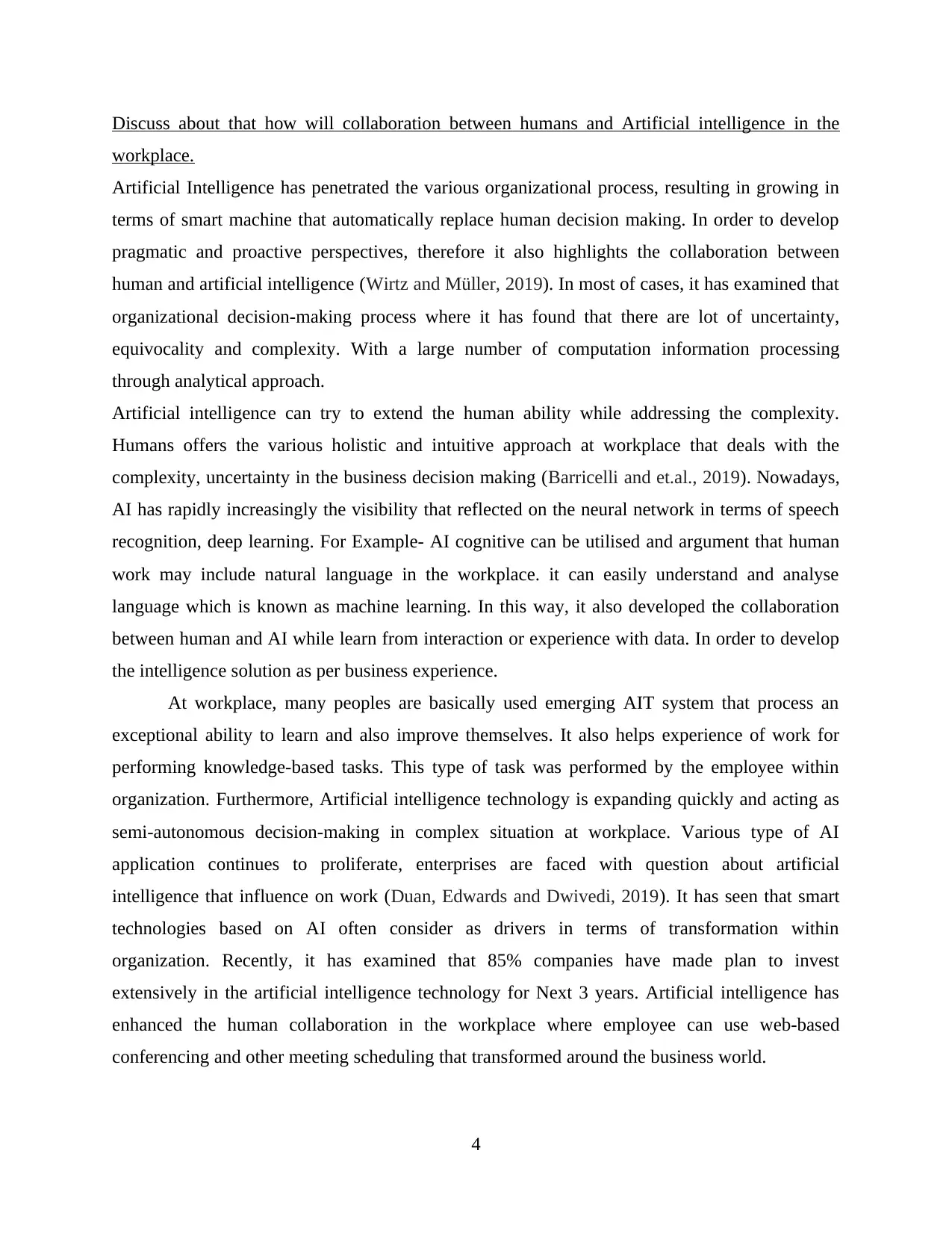
Discuss about that how will collaboration between humans and Artificial intelligence in the
workplace.
Artificial Intelligence has penetrated the various organizational process, resulting in growing in
terms of smart machine that automatically replace human decision making. In order to develop
pragmatic and proactive perspectives, therefore it also highlights the collaboration between
human and artificial intelligence (Wirtz and Müller, 2019). In most of cases, it has examined that
organizational decision-making process where it has found that there are lot of uncertainty,
equivocality and complexity. With a large number of computation information processing
through analytical approach.
Artificial intelligence can try to extend the human ability while addressing the complexity.
Humans offers the various holistic and intuitive approach at workplace that deals with the
complexity, uncertainty in the business decision making (Barricelli and et.al., 2019). Nowadays,
AI has rapidly increasingly the visibility that reflected on the neural network in terms of speech
recognition, deep learning. For Example- AI cognitive can be utilised and argument that human
work may include natural language in the workplace. it can easily understand and analyse
language which is known as machine learning. In this way, it also developed the collaboration
between human and AI while learn from interaction or experience with data. In order to develop
the intelligence solution as per business experience.
At workplace, many peoples are basically used emerging AIT system that process an
exceptional ability to learn and also improve themselves. It also helps experience of work for
performing knowledge-based tasks. This type of task was performed by the employee within
organization. Furthermore, Artificial intelligence technology is expanding quickly and acting as
semi-autonomous decision-making in complex situation at workplace. Various type of AI
application continues to proliferate, enterprises are faced with question about artificial
intelligence that influence on work (Duan, Edwards and Dwivedi, 2019). It has seen that smart
technologies based on AI often consider as drivers in terms of transformation within
organization. Recently, it has examined that 85% companies have made plan to invest
extensively in the artificial intelligence technology for Next 3 years. Artificial intelligence has
enhanced the human collaboration in the workplace where employee can use web-based
conferencing and other meeting scheduling that transformed around the business world.
4
workplace.
Artificial Intelligence has penetrated the various organizational process, resulting in growing in
terms of smart machine that automatically replace human decision making. In order to develop
pragmatic and proactive perspectives, therefore it also highlights the collaboration between
human and artificial intelligence (Wirtz and Müller, 2019). In most of cases, it has examined that
organizational decision-making process where it has found that there are lot of uncertainty,
equivocality and complexity. With a large number of computation information processing
through analytical approach.
Artificial intelligence can try to extend the human ability while addressing the complexity.
Humans offers the various holistic and intuitive approach at workplace that deals with the
complexity, uncertainty in the business decision making (Barricelli and et.al., 2019). Nowadays,
AI has rapidly increasingly the visibility that reflected on the neural network in terms of speech
recognition, deep learning. For Example- AI cognitive can be utilised and argument that human
work may include natural language in the workplace. it can easily understand and analyse
language which is known as machine learning. In this way, it also developed the collaboration
between human and AI while learn from interaction or experience with data. In order to develop
the intelligence solution as per business experience.
At workplace, many peoples are basically used emerging AIT system that process an
exceptional ability to learn and also improve themselves. It also helps experience of work for
performing knowledge-based tasks. This type of task was performed by the employee within
organization. Furthermore, Artificial intelligence technology is expanding quickly and acting as
semi-autonomous decision-making in complex situation at workplace. Various type of AI
application continues to proliferate, enterprises are faced with question about artificial
intelligence that influence on work (Duan, Edwards and Dwivedi, 2019). It has seen that smart
technologies based on AI often consider as drivers in terms of transformation within
organization. Recently, it has examined that 85% companies have made plan to invest
extensively in the artificial intelligence technology for Next 3 years. Artificial intelligence has
enhanced the human collaboration in the workplace where employee can use web-based
conferencing and other meeting scheduling that transformed around the business world.
4
Paraphrase This Document
Need a fresh take? Get an instant paraphrase of this document with our AI Paraphraser
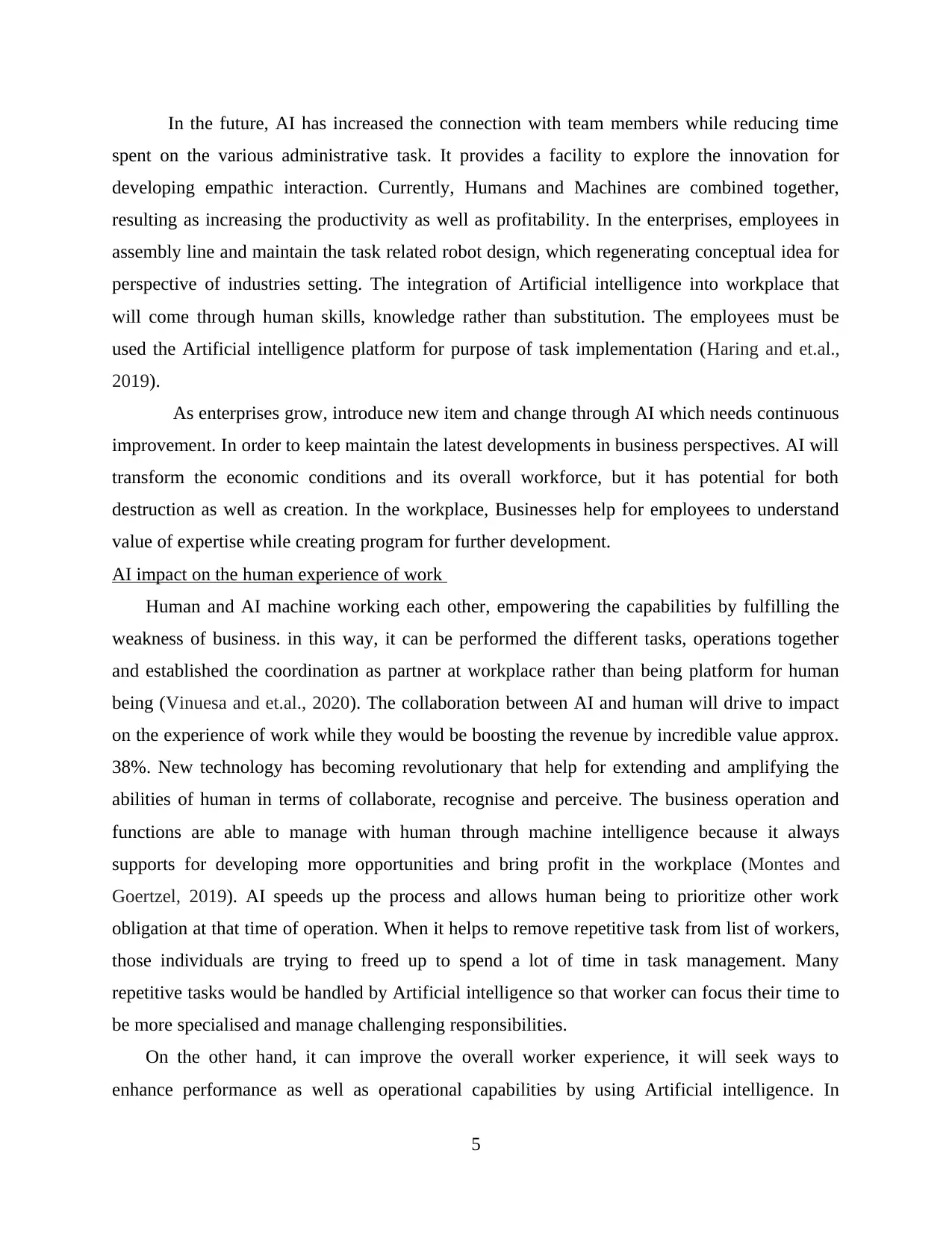
In the future, AI has increased the connection with team members while reducing time
spent on the various administrative task. It provides a facility to explore the innovation for
developing empathic interaction. Currently, Humans and Machines are combined together,
resulting as increasing the productivity as well as profitability. In the enterprises, employees in
assembly line and maintain the task related robot design, which regenerating conceptual idea for
perspective of industries setting. The integration of Artificial intelligence into workplace that
will come through human skills, knowledge rather than substitution. The employees must be
used the Artificial intelligence platform for purpose of task implementation (Haring and et.al.,
2019).
As enterprises grow, introduce new item and change through AI which needs continuous
improvement. In order to keep maintain the latest developments in business perspectives. AI will
transform the economic conditions and its overall workforce, but it has potential for both
destruction as well as creation. In the workplace, Businesses help for employees to understand
value of expertise while creating program for further development.
AI impact on the human experience of work
Human and AI machine working each other, empowering the capabilities by fulfilling the
weakness of business. in this way, it can be performed the different tasks, operations together
and established the coordination as partner at workplace rather than being platform for human
being (Vinuesa and et.al., 2020). The collaboration between AI and human will drive to impact
on the experience of work while they would be boosting the revenue by incredible value approx.
38%. New technology has becoming revolutionary that help for extending and amplifying the
abilities of human in terms of collaborate, recognise and perceive. The business operation and
functions are able to manage with human through machine intelligence because it always
supports for developing more opportunities and bring profit in the workplace (Montes and
Goertzel, 2019). AI speeds up the process and allows human being to prioritize other work
obligation at that time of operation. When it helps to remove repetitive task from list of workers,
those individuals are trying to freed up to spend a lot of time in task management. Many
repetitive tasks would be handled by Artificial intelligence so that worker can focus their time to
be more specialised and manage challenging responsibilities.
On the other hand, it can improve the overall worker experience, it will seek ways to
enhance performance as well as operational capabilities by using Artificial intelligence. In
5
spent on the various administrative task. It provides a facility to explore the innovation for
developing empathic interaction. Currently, Humans and Machines are combined together,
resulting as increasing the productivity as well as profitability. In the enterprises, employees in
assembly line and maintain the task related robot design, which regenerating conceptual idea for
perspective of industries setting. The integration of Artificial intelligence into workplace that
will come through human skills, knowledge rather than substitution. The employees must be
used the Artificial intelligence platform for purpose of task implementation (Haring and et.al.,
2019).
As enterprises grow, introduce new item and change through AI which needs continuous
improvement. In order to keep maintain the latest developments in business perspectives. AI will
transform the economic conditions and its overall workforce, but it has potential for both
destruction as well as creation. In the workplace, Businesses help for employees to understand
value of expertise while creating program for further development.
AI impact on the human experience of work
Human and AI machine working each other, empowering the capabilities by fulfilling the
weakness of business. in this way, it can be performed the different tasks, operations together
and established the coordination as partner at workplace rather than being platform for human
being (Vinuesa and et.al., 2020). The collaboration between AI and human will drive to impact
on the experience of work while they would be boosting the revenue by incredible value approx.
38%. New technology has becoming revolutionary that help for extending and amplifying the
abilities of human in terms of collaborate, recognise and perceive. The business operation and
functions are able to manage with human through machine intelligence because it always
supports for developing more opportunities and bring profit in the workplace (Montes and
Goertzel, 2019). AI speeds up the process and allows human being to prioritize other work
obligation at that time of operation. When it helps to remove repetitive task from list of workers,
those individuals are trying to freed up to spend a lot of time in task management. Many
repetitive tasks would be handled by Artificial intelligence so that worker can focus their time to
be more specialised and manage challenging responsibilities.
On the other hand, it can improve the overall worker experience, it will seek ways to
enhance performance as well as operational capabilities by using Artificial intelligence. In
5
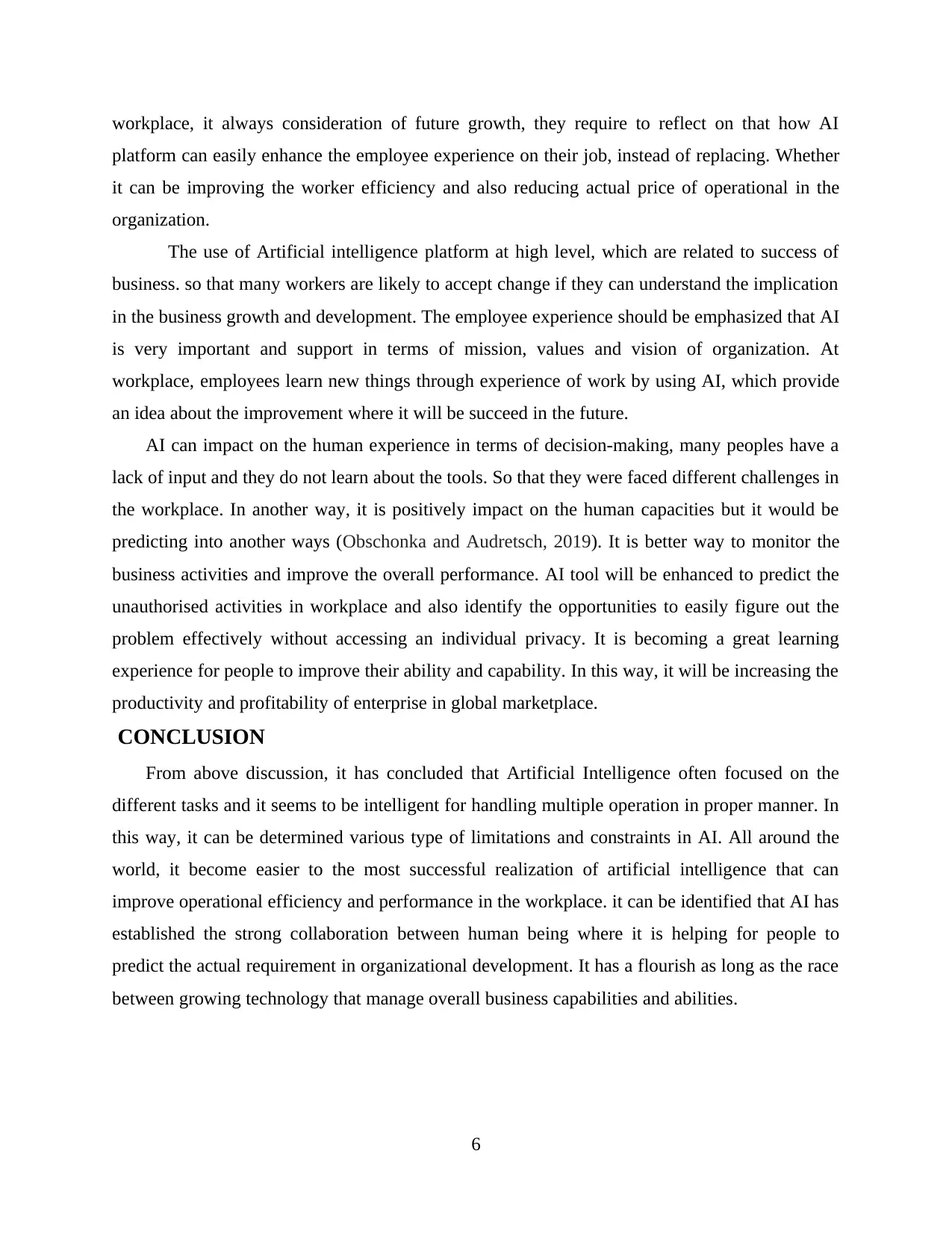
workplace, it always consideration of future growth, they require to reflect on that how AI
platform can easily enhance the employee experience on their job, instead of replacing. Whether
it can be improving the worker efficiency and also reducing actual price of operational in the
organization.
The use of Artificial intelligence platform at high level, which are related to success of
business. so that many workers are likely to accept change if they can understand the implication
in the business growth and development. The employee experience should be emphasized that AI
is very important and support in terms of mission, values and vision of organization. At
workplace, employees learn new things through experience of work by using AI, which provide
an idea about the improvement where it will be succeed in the future.
AI can impact on the human experience in terms of decision-making, many peoples have a
lack of input and they do not learn about the tools. So that they were faced different challenges in
the workplace. In another way, it is positively impact on the human capacities but it would be
predicting into another ways (Obschonka and Audretsch, 2019). It is better way to monitor the
business activities and improve the overall performance. AI tool will be enhanced to predict the
unauthorised activities in workplace and also identify the opportunities to easily figure out the
problem effectively without accessing an individual privacy. It is becoming a great learning
experience for people to improve their ability and capability. In this way, it will be increasing the
productivity and profitability of enterprise in global marketplace.
CONCLUSION
From above discussion, it has concluded that Artificial Intelligence often focused on the
different tasks and it seems to be intelligent for handling multiple operation in proper manner. In
this way, it can be determined various type of limitations and constraints in AI. All around the
world, it become easier to the most successful realization of artificial intelligence that can
improve operational efficiency and performance in the workplace. it can be identified that AI has
established the strong collaboration between human being where it is helping for people to
predict the actual requirement in organizational development. It has a flourish as long as the race
between growing technology that manage overall business capabilities and abilities.
6
platform can easily enhance the employee experience on their job, instead of replacing. Whether
it can be improving the worker efficiency and also reducing actual price of operational in the
organization.
The use of Artificial intelligence platform at high level, which are related to success of
business. so that many workers are likely to accept change if they can understand the implication
in the business growth and development. The employee experience should be emphasized that AI
is very important and support in terms of mission, values and vision of organization. At
workplace, employees learn new things through experience of work by using AI, which provide
an idea about the improvement where it will be succeed in the future.
AI can impact on the human experience in terms of decision-making, many peoples have a
lack of input and they do not learn about the tools. So that they were faced different challenges in
the workplace. In another way, it is positively impact on the human capacities but it would be
predicting into another ways (Obschonka and Audretsch, 2019). It is better way to monitor the
business activities and improve the overall performance. AI tool will be enhanced to predict the
unauthorised activities in workplace and also identify the opportunities to easily figure out the
problem effectively without accessing an individual privacy. It is becoming a great learning
experience for people to improve their ability and capability. In this way, it will be increasing the
productivity and profitability of enterprise in global marketplace.
CONCLUSION
From above discussion, it has concluded that Artificial Intelligence often focused on the
different tasks and it seems to be intelligent for handling multiple operation in proper manner. In
this way, it can be determined various type of limitations and constraints in AI. All around the
world, it become easier to the most successful realization of artificial intelligence that can
improve operational efficiency and performance in the workplace. it can be identified that AI has
established the strong collaboration between human being where it is helping for people to
predict the actual requirement in organizational development. It has a flourish as long as the race
between growing technology that manage overall business capabilities and abilities.
6
⊘ This is a preview!⊘
Do you want full access?
Subscribe today to unlock all pages.

Trusted by 1+ million students worldwide
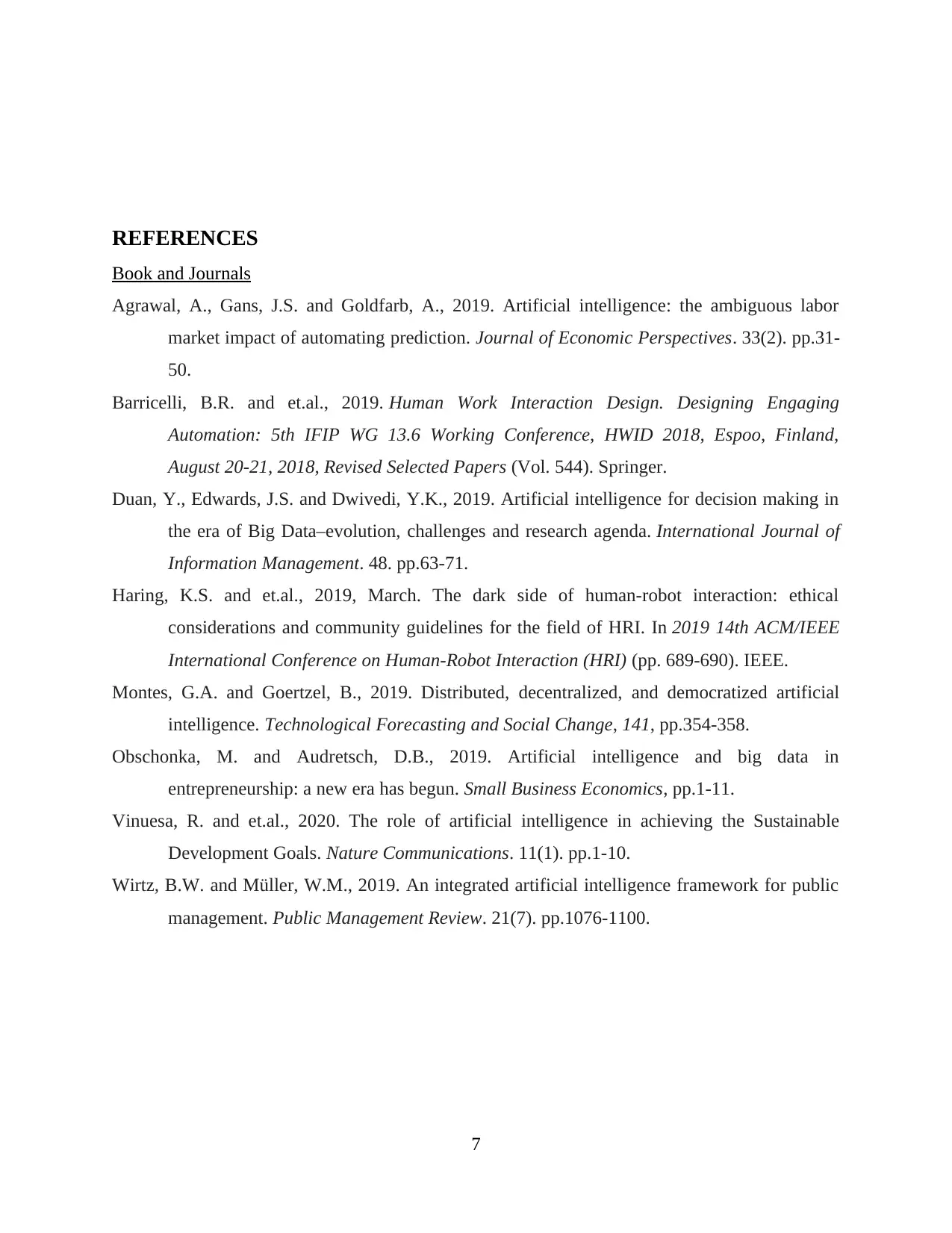
REFERENCES
Book and Journals
Agrawal, A., Gans, J.S. and Goldfarb, A., 2019. Artificial intelligence: the ambiguous labor
market impact of automating prediction. Journal of Economic Perspectives. 33(2). pp.31-
50.
Barricelli, B.R. and et.al., 2019. Human Work Interaction Design. Designing Engaging
Automation: 5th IFIP WG 13.6 Working Conference, HWID 2018, Espoo, Finland,
August 20-21, 2018, Revised Selected Papers (Vol. 544). Springer.
Duan, Y., Edwards, J.S. and Dwivedi, Y.K., 2019. Artificial intelligence for decision making in
the era of Big Data–evolution, challenges and research agenda. International Journal of
Information Management. 48. pp.63-71.
Haring, K.S. and et.al., 2019, March. The dark side of human-robot interaction: ethical
considerations and community guidelines for the field of HRI. In 2019 14th ACM/IEEE
International Conference on Human-Robot Interaction (HRI) (pp. 689-690). IEEE.
Montes, G.A. and Goertzel, B., 2019. Distributed, decentralized, and democratized artificial
intelligence. Technological Forecasting and Social Change, 141, pp.354-358.
Obschonka, M. and Audretsch, D.B., 2019. Artificial intelligence and big data in
entrepreneurship: a new era has begun. Small Business Economics, pp.1-11.
Vinuesa, R. and et.al., 2020. The role of artificial intelligence in achieving the Sustainable
Development Goals. Nature Communications. 11(1). pp.1-10.
Wirtz, B.W. and Müller, W.M., 2019. An integrated artificial intelligence framework for public
management. Public Management Review. 21(7). pp.1076-1100.
7
Book and Journals
Agrawal, A., Gans, J.S. and Goldfarb, A., 2019. Artificial intelligence: the ambiguous labor
market impact of automating prediction. Journal of Economic Perspectives. 33(2). pp.31-
50.
Barricelli, B.R. and et.al., 2019. Human Work Interaction Design. Designing Engaging
Automation: 5th IFIP WG 13.6 Working Conference, HWID 2018, Espoo, Finland,
August 20-21, 2018, Revised Selected Papers (Vol. 544). Springer.
Duan, Y., Edwards, J.S. and Dwivedi, Y.K., 2019. Artificial intelligence for decision making in
the era of Big Data–evolution, challenges and research agenda. International Journal of
Information Management. 48. pp.63-71.
Haring, K.S. and et.al., 2019, March. The dark side of human-robot interaction: ethical
considerations and community guidelines for the field of HRI. In 2019 14th ACM/IEEE
International Conference on Human-Robot Interaction (HRI) (pp. 689-690). IEEE.
Montes, G.A. and Goertzel, B., 2019. Distributed, decentralized, and democratized artificial
intelligence. Technological Forecasting and Social Change, 141, pp.354-358.
Obschonka, M. and Audretsch, D.B., 2019. Artificial intelligence and big data in
entrepreneurship: a new era has begun. Small Business Economics, pp.1-11.
Vinuesa, R. and et.al., 2020. The role of artificial intelligence in achieving the Sustainable
Development Goals. Nature Communications. 11(1). pp.1-10.
Wirtz, B.W. and Müller, W.M., 2019. An integrated artificial intelligence framework for public
management. Public Management Review. 21(7). pp.1076-1100.
7
Paraphrase This Document
Need a fresh take? Get an instant paraphrase of this document with our AI Paraphraser

8
1 out of 8
Related Documents
Your All-in-One AI-Powered Toolkit for Academic Success.
+13062052269
info@desklib.com
Available 24*7 on WhatsApp / Email
![[object Object]](/_next/static/media/star-bottom.7253800d.svg)
Unlock your academic potential
Copyright © 2020–2025 A2Z Services. All Rights Reserved. Developed and managed by ZUCOL.





